These handmade Tibetan vegetable momos are served with a spicy tomato sesame chutney and make a delicious appetizer or snack!
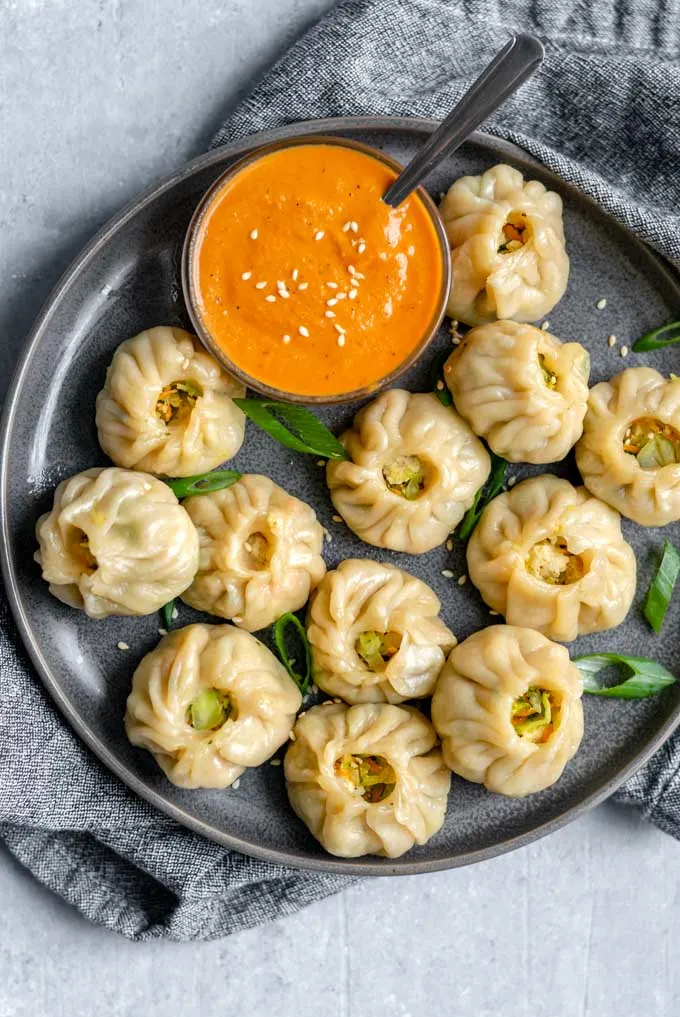
I’m really excited to share today’s recipe with you. These Tibetan momos are a food that is as cute as the name sounds!
We’re talking dumplings, stuffed with a delicious cabbage, carrot, and onion filling. Spiced with garlic, ginger, cilantro, and a very generous amount of black pepper.
Studded with crumbled tofu and wrapped up in the cutest little round package, steamed and then served with a mouth watering spicy sesame tomato chutney.
It’s unclear whether momos have reached foodie fame because of their cute name, because they are really fun to eat, or because they’re crazy good. If you’ve never had a momo, it’s easy to fix!
You don’t need any special ingredients for this dumpling recipe, and the only “fancy” equipment you need is some steamer set up for your stove.
Momos are a great first foray into Tibetan food if you’re unfamiliar. Tibetan food is not traditionally the most vegan friendly cuisine, as the country’s high altitudes make growing crops a challenge. But vegetarian offerings are easier to find outside of Tibet, and it’s not a challenge to stuff a vegetable filling into dumpling dough!
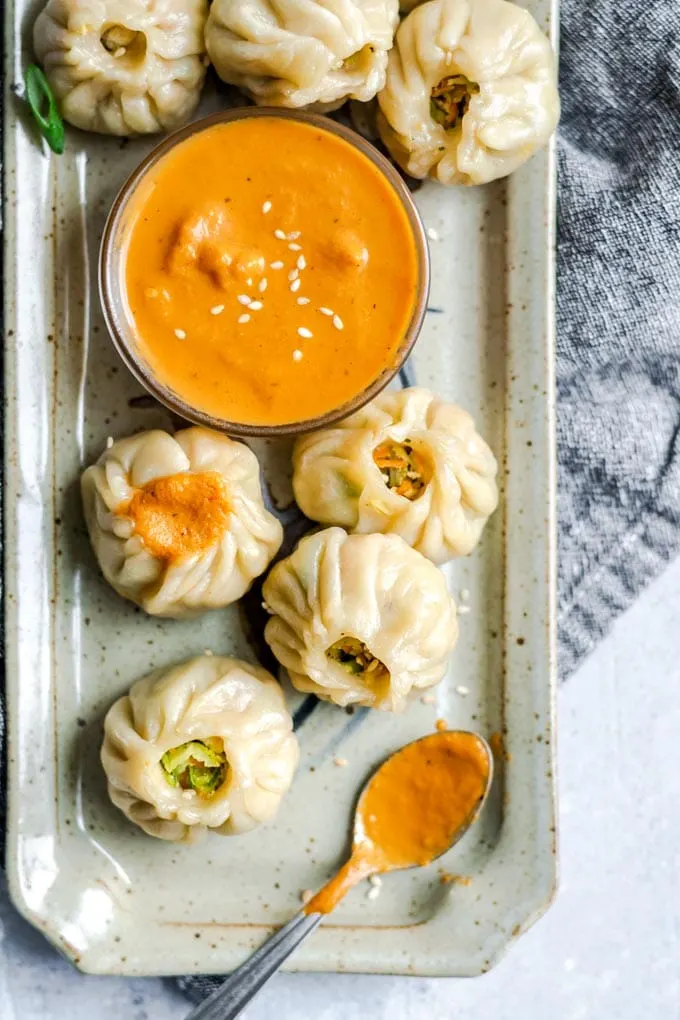
I grew up in a college town in the Midwest, and while it was quite a diverse community with a lot of opportunities to get out of your comfort zone, it was still easy to encounter people who had little experience with foods from other cultures.
I once had a friend’s parent ask me if Thai food was like Indian food. At the time, 16 year old Eva thought that was a joke, how could two cuisines be any more different??!
But thinking back, if you’re consuming the SAD (standard American diet), a boldly flavored Thai cuisine might remind your taste buds of spicy Indian cuisine. And things get fuzzier for me when we move into areas that are bordering one another.
So if you asked me if Tibetan food was like Indian or Nepalese or Chinese food, well, not exactly as it’s its own thing.. but you do start to see overlap of flavors and types of dishes when countries border each other. There’s also the matter that India and China are big and diverse countries themselves with many different cuisines within them.
I guess all I’m trying to say here is that if you enjoy foods and flavors from Asian cuisines and haven’t ventured into Tibetan cooking or restaurants give it a go! Tibetan momos are a cute and familiar food, with variations of dumplings found across the Asian continent (and around the world).
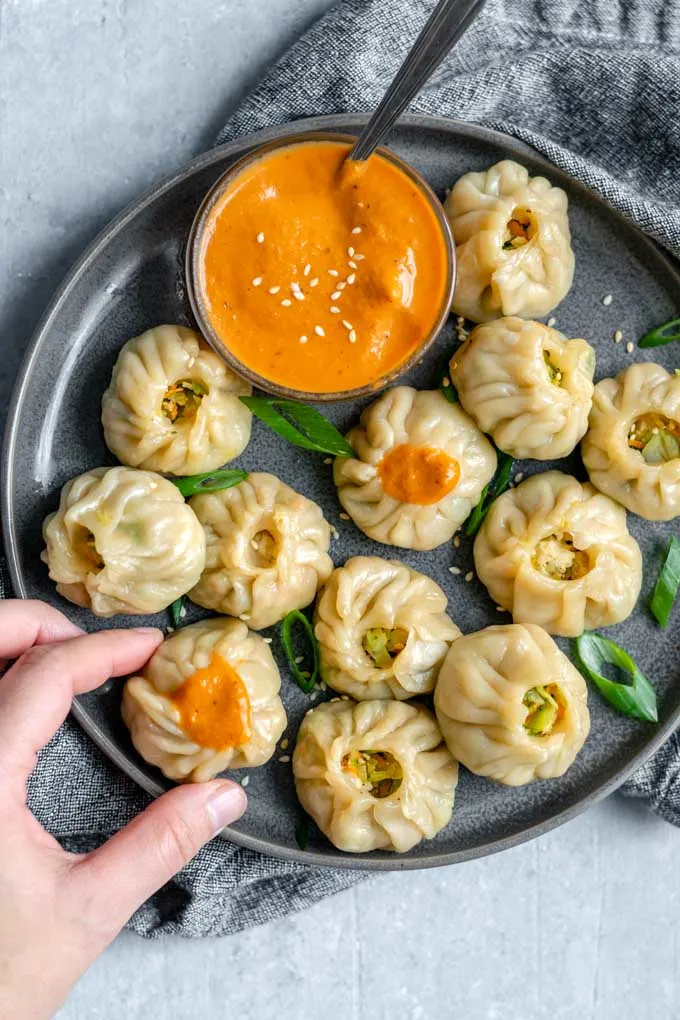
How to make momo:
As complicated as they look, momo are actually really simple to make. Essentially, you mix together a 4-ingredient dough then let it rest while you pull together the filling. Next, roll out the dough, cut it into circles, add the filling, then fold and pleat the dough into your desired dumpling shape. Steam them, and eat them with chutney while hot!
Whipping up a batch of momo now takes me just 1 hour, some of that time being hands off, and then maybe 15 minutes at the end to steam all of them. Your first time might take a bit longer, and if you have a helper you can really cut that time down!
Ok now let’s talk more detail: first, the dumpling dough.
It’s an easy recipe, using just flour, salt, water, and a little oil. The oil makes the dough more supple and helps keep it from drying out. As such I don’t recommend leaving it out for momo- and dumpling-newbies.
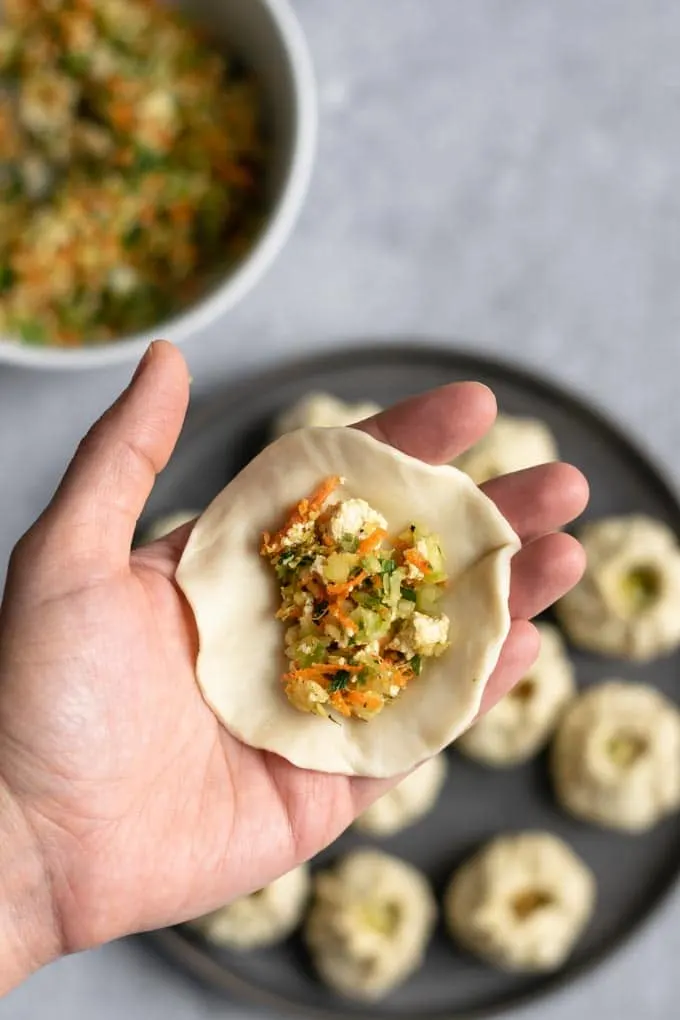
Mix the flour and salt to integrate the salt, then add the water and oil. Combine to create a shaggy dough, then turn the dough onto a clean and floured counter and knead the dough until it comes together to form a smooth ball. Add more flour as needed to keep it from sticking, and at the end the dough should be just barely tacky.
Usually the dough comes together in just 5 minutes, then stick it back in the bowl and cover with a damp kitchen towel. The damp towel keeps the dough fresh and hydrated. Let the dough rest for at least 30 minutes, but you can also make it a couple of hours in advance.
Resting the dough is essential as it gives the gluten a chance to relax and the flour a chance to absorb the water so it’s easier to handle. If you skip this step rolling the dough out thinly is going to be a probably unsuccessful nightmare.
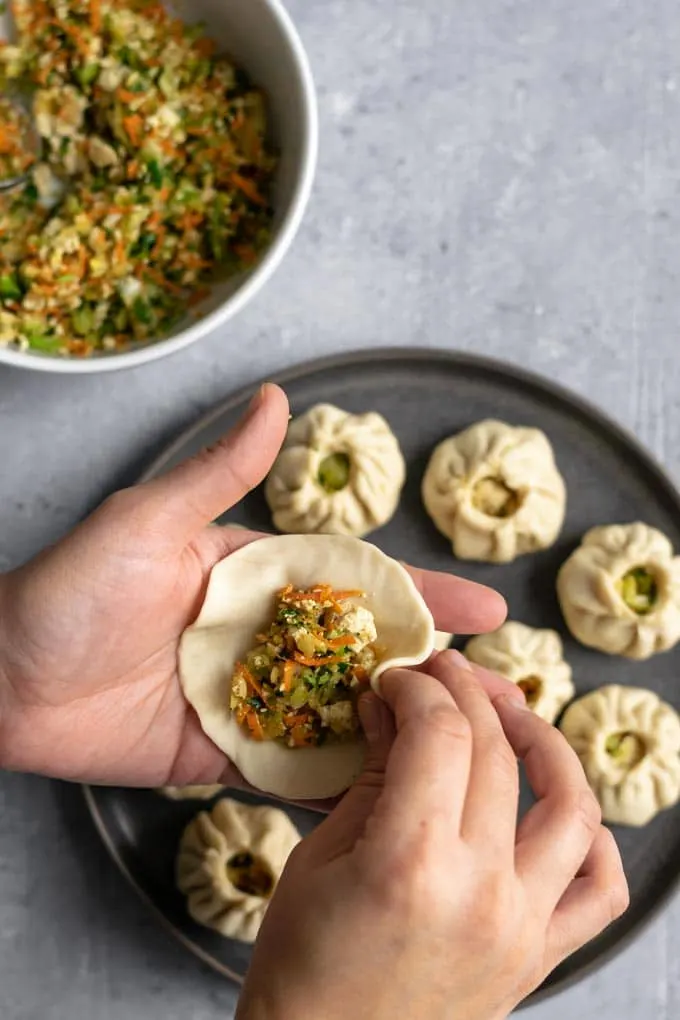
While the dough rests, we whip up the vegetable filling.
In my momo research, I came across two common ways to prepare the filling. One is to cook the filling before making the dumplings, the other is to encourage the vegetables to release their water with salt and to not cook the filling. I went with the second option, as I liked the idea of cutting out the extra step of cooking and think it leads to a juicier filling.
First shred your cabbage. I found this to be a bit of a pain on a box grater, and recommend if you do so, don’t cut the cabbage first but instead keep the entire head intact while you shred.
Alternatively you can use a food processor or chop everything up extra finely by hand. Shredding carrots is a bit easier, they can shredded by box grater, food processor (I recommend grating then switching to a S-curve blade and pulsing to chop it extra finely) or by mincing with a knife.
Add the cabbage and carrots to a large mixing bowl and toss in thinly sliced scallions. Add the 2 teaspoons of salt and toss everything to combine. Let the vegetables sit for 5-10 minutes, which gives the salt a chance to release the water in the cabbage. Then squeeze out that water.
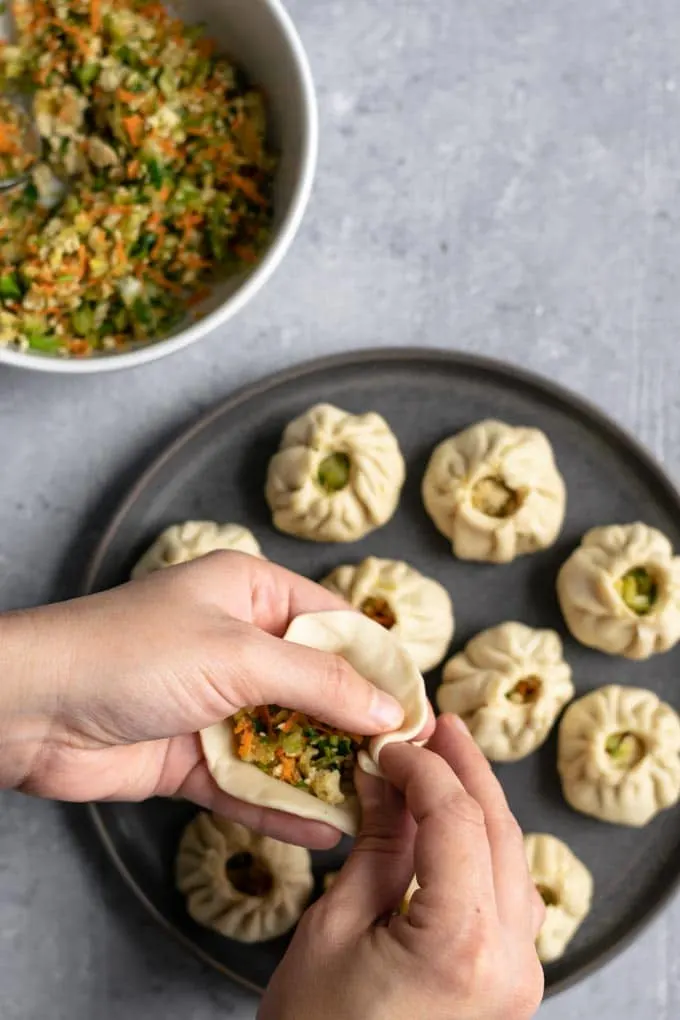
This is easily done through a nut milk bag, muslin, a thin kitchen towel, or a few layers of cheese cloth. You don’t need to squeeze out every last drop of moisture, just give it a few good squeezes so you don’t get a watery momo filling.
Next we add the remaining ingredients to the filling: ginger, garlic, and cilantro are the only spices we need here. Well, along with a generous addition of freshly ground black pepper.
Add crumbled tofu (which sneakily means you can enjoy these Tibetan dumplings as a complete meal, as long as you eat enough to fill you up!) and a drizzle of oil. The oil adds richness to the filling and keeps it juicy. Taste the filling as you may find it needs an extra sprinkle of salt since a lot of the salt was squeezed out of it before.
At this point you can relax a little, do the dishes, twiddle your thumbs, make the chutney, or whatever you’d like while you wait for your dough to finish resting.
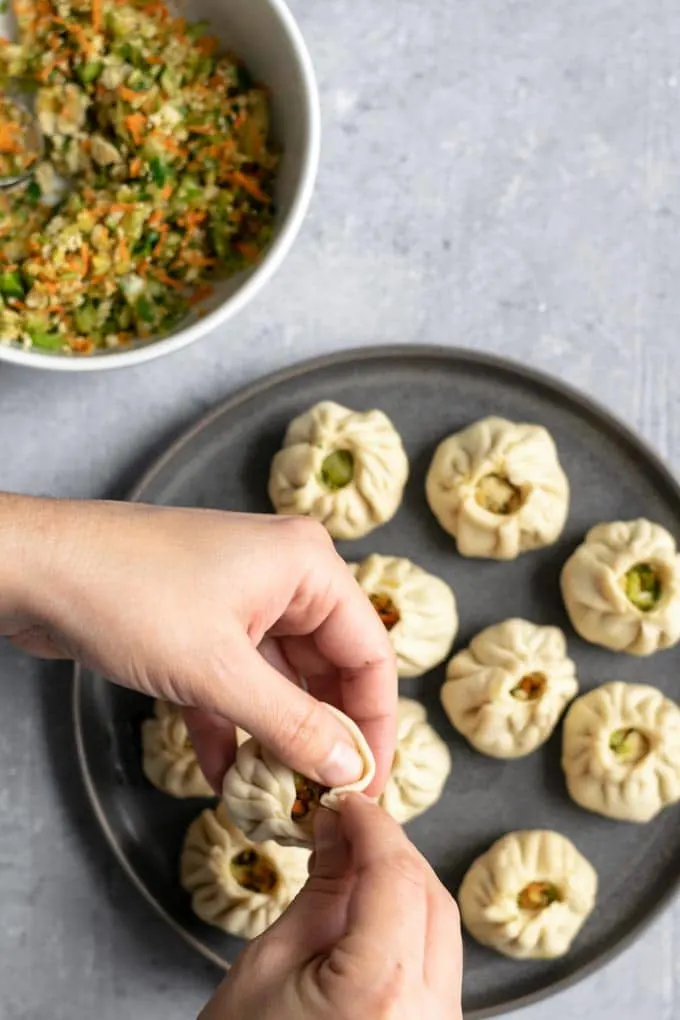
Shaping the momo:
There are many ways to shape momo dumplings and this is just one way, and you don’t have to do it my way if you’d prefer a different method. To start, we roll out the dough thinly. You can pull off small pieces of dough (golf ball sized-ish) and roll them into ~4-inch circles, but I find this to take a lot longer and be more challenging.
Instead, I divide the dough into two pieces and roll out a large thin sheet of dough. Then I take a biscuit cutter (but any round cookie cutter, an overturned glass, or a properly sized lid can be used) to cut out large circles. You want 3 1/2″ to 4″ circles.
You can always roll the circles out a little bit more after they’ve been cut if you’d like or if you need to get them a bit thinner. Pull away the scraps of dough after cutting and return it to the mixing bowl to cover with the damp cloth.
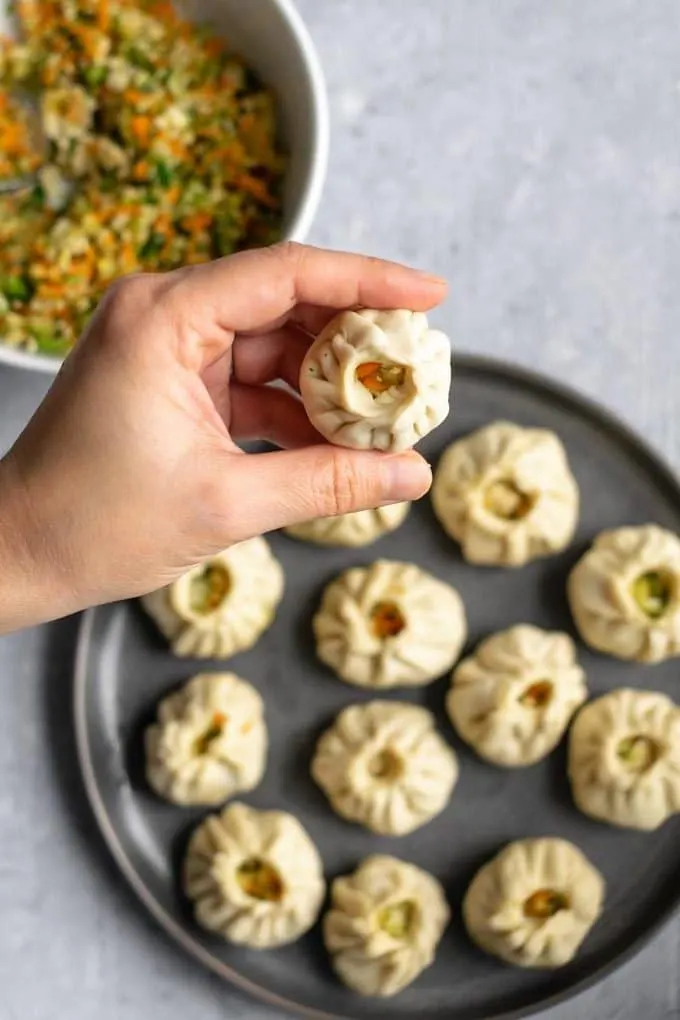
Next, I will try to explain the process of how I fold the dough to shape the momo, but please refer to the video at the end of the post for visuals!
Place one circle of dough in the palm of your non-dominant hand. You can leave the remaining circles of dough out as long as you aren’t super slow (otherwise cover them with a damp towel so they don’t dry out too much).
I’m able to make about a dozen at a time without the dough drying out too much while I shape, but I do flip them over so the stickier side faces up on my palm. Add about 1 tbsp of filling to center of the dough, then using the thumb and pointer finger of your dominant hand to flute the dough and pinch it together.
Your dominant hand thumb stays in place while your pointer finger and your non-dominant hand thumb help push the remaining dough to flute and seal. Once all the dough from the circumference of the circle has been used you can either leave it open as I have here, or press the last flap of dough across to seal the top for a closed dumpling.
Set aside completed dumplings on a lightly greased plate or baking tray. You want to either spray or brush with a thin layer of oil so that the dough does not stick to the plate. You can leave them out and continue with the next dumplings. Repeat until you’ve shaped all of the dumplings. Rolling out new sheets of dough until you’ve used up either all the filling or all the dough. It should be pretty close to all of both though with these measurements.
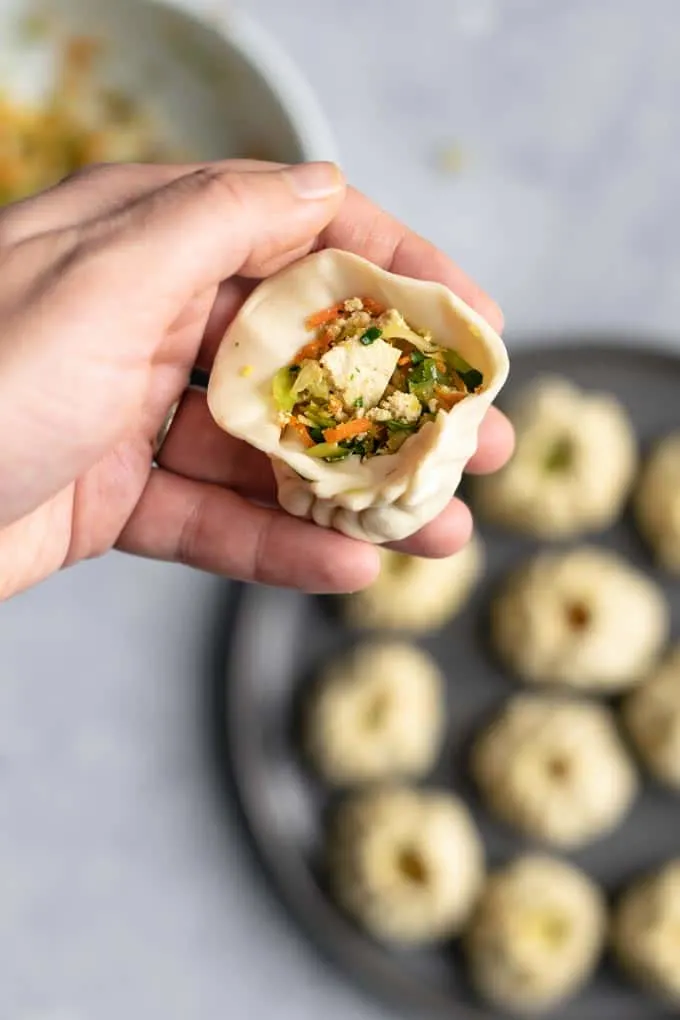
Cooking the momo:
Momo can be either steamed or deep fried to cook (if deep frying you will want to seal the center of the dumplings so that they are not open and the filling doesn’t fall out). And I never thought I would say this, but I actually prefer the steamed version of these dumplings! And with the added bonus points for it being healthier, it’s the only cooking option I’m sharing today.
Prepare your steamer, and this can be a pot with a steamer insert (this is what I use), a bamboo steamer basket, or even a steamer insert for your regular pot.
Lightly oil the steamer basket/insert/whatever you’re using to keep the dumplings from sticking, then arrange the dumplings in the basket so that they don’t touch. They don’t drastically change in size, but you want to make sure there’s plenty of room for steam to flow around them, and you don’t want them to stick together.
Steam the dumplings for about 5 minutes, they are done cooking when they are not sticky to the touch. Be careful to not burn yourself while you are checking them! When done, pull them out (tongs make easy work of this) and serve immediately. Add more dumplings to the steamer and cook until you’ve made them all!
Momos can also be stored in a sealed container in the fridge for at least a day (I haven’t tried longer and I’m not sure I would recommend making them much more in advance) and steamed at a later time straight from the fridge. You can also successfully rewarm cooked momo by steaming them again, I find another 5 minutes does the trick!

Making the spicy sesame tomato chutney:
Now you don’t want to serve momo without a chutney (sauce) to go with it! A local Himalayan restaurant here serves theirs with a sesame chutney and I’m a little bit obsessed over (#willtravelforchutney), and I really wanted to recreate it for you!
This isn’t an exact copycat of their chutney, but I could basically eat this like it was soup. And I would if it didn’t have such a kick to it (which you can cut back on)!
This chutney is made with sesame seeds, crushed red pepper (you can substitute dried red chilies if you’d like), garlic and ginger for extra spice and zing, red onion for a little natural sweetness, tomato for acidity and it’s sweetness, soy sauce for deep salty flavor, and lemon juice to brighten the flavors.
The ingredients get sautéed then blended up to make a smooth sauce and thinned with water so it’s a nice pourable consistency! You can always cut back or even cut out the chili peppers for delicious heat free flavor if that’s what you need.
These momos are also delicious with both of my Afghan chutney recipes if that’s more your speed. But whatever you make, I like to do so in advance. The spice (yes, heat) mellows as the chutney sits and the flavors get a chance to meld.
I will note this sesame tomato chutney makes a lot, so you might want to think about cutting the recipe in half, making extra batches of momos, or even freezing extra. You can also use the chutney as you would a hot sauce to top other foods. You might find it disappears in no time!
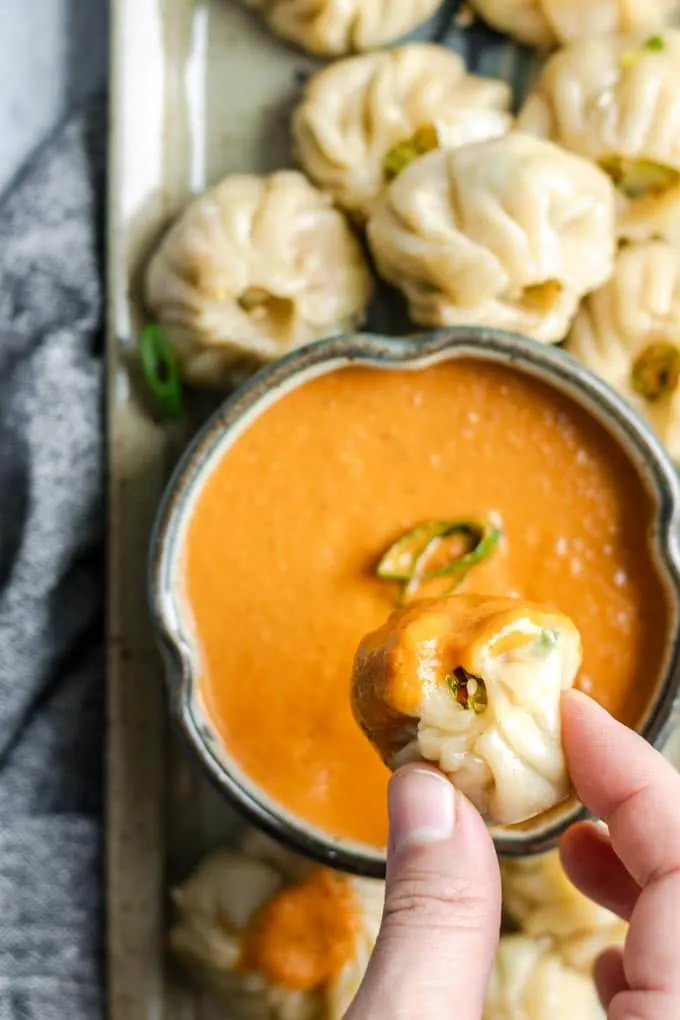
Enjoy your momo!
Once all your momo are done, you really are in for the best treat! They’re a real crowd pleaser, and not just because the name is insanely fun to say. They’re gobbled up in no time, whether you make them just for you and your partner or roommate, or if you make them for a party!
I served these last week as part of an appetizer spread, and sitting next to a plate of latkes (aka delicious fried potato pancakes) the momos were the easy favorite. It’s just hard to say no to dumpling perfection! Though I’ll admit I was a bit sad that I didn’t have any leftover momo!
As my husband Omar likes to say, before you know it there are no-mo-momo and it’s time to make mo momo! So let that be a lesson to you dumpling lovers out there. And make yourself some momo!
If you enjoyed this recipe, check out and share my Tibetan Vegetable Momo Story with your family and friends! Thank you!
If you make these Tibetan vegetable momo and/or the tomato chutney, leave a comment below and rate the recipe on the recipe card. And please share your photos with me on Instagram, tag @thecuriouschickpea and #thecuriouschickpea. I love seeing your recreations!
WANT MORE DELICIOUS VEGAN RECIPES?
SIGN UP FOR MY EMAIL NEWSLETTER & FOLLOW ME ON INSTAGRAM, FACEBOOK, AND PINTEREST!
Notes:
The filling for these momo are not set in stone. If you hate cilantro, leave it out! You can add some shredded red or yellow onion, leave out the tofu (but then add extra cabbage or you won’t have enough filling) or use a seitan sausage instead, add minced green beans, substitute shredded savoy or napa cabbage.. really whatever you want! Any water heavy vegetables should be added at the first step and salted so that they don’t make a soggy filling.
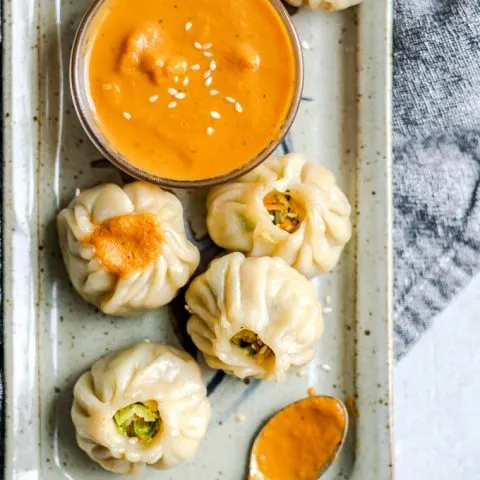
Tibetan Vegetable Momos
These handmade Tibetan vegetable momos are delicious dumplings, stuffed with an easy cabbage and tofu filling.
Ingredients
Dough
- 2 cups all purpose flour, more as needed
- 1/2 tsp salt
- 1 tbsp oil
- 3/4 cup water
Filling
- 2 cups (180g) shredded green cabbage
- 3/4 cup (70g) shredded carrot
- 1/2 cup (45g) thinly sliced scallions, white and green parts
- 2 tsp salt, more to taste
- 1 tbsp minced ginger
- 3-4 cloves garlic, minced
- 1/4 cup minced cilantro
- 4 oz extra firm tofu, crumbled
- 1 tsp ground black pepper
- 2 tsp oil
Instructions
- Make the dumpling dough: In a mixing bowl whisk together the flour and salt. Add the water and oil and mix the dough until it comes together. Turn out onto a floured counter and knead the dough, adding more flour as necessary, until you have a smooth and barely tacky dough. Put the dough back in the mixing bowl and cover with a damp towel. Let the dough rest for 30 minutes while you prepare the filling.
- Add the shredded cabbage, shredded carrot, and sliced scallions in a large mixing bowl. Add the salt and toss to combine. Let the mixture sit for 5-10 minutes, then squeeze out extra water from the cabbage. You can do it easily in a thin tea towel, nut milk bag, muslin or layered cheese cloth.
- Dump out the water and add the vegetables back into the mixing bowl. Toss with the ginger, garlic, cilantro tofu, black pepper, and oil. Taste and add salt if needed.
- When the dough has rested for a half an hour, divide it in half. Leave one half under the damp towel, and roll the second half out on a lightly floured counter until it is very thin, basically as thin as you can roll it. Lift the dough and rotate, flip and dust with more flour as you roll to keep it from sticking.
- Cut the dough into 3 1/2 - 4 inch circles. Remove the scraps of dough and place it back under the damp towel.
- Taking one piece of dough at a time, place it in the palm of your non-dominant hand. Put about 1 tablespoon of filling in the center of the dough, then fold and pinch the dough together to form a round momo. If you would like you can pinch the dough together at the end to seal the center, or leave it open as pictured. Watch the video for more details on how to shape the momos.
- Place finished momos on a lightly oiled plate and repeat with the remaining dough, rolling out the other half when needed, and re-rolling the scraps until all dough and/or filling is used up.
- Prepare a steamer pot, filling it with water and bringing it to a boil over medium-high heat. Place momos on a lightly greased steamer basket, leaving space between each dumpling. Steam for 5 minutes, or until the dough is not sticky to the touch and remove using tongs. Repeat with remaining dumplings.
- Serve the dumplings warm with chutney. Leftover dumplings can be reheated by steaming them again.
Notes
Recipe adapted from YoWangdu.
Recommended Products
As an Amazon Associate and member of other affiliate programs, I earn from qualifying purchases.
Nutrition Information:
Yield: 5 Serving Size: 6 momoAmount Per Serving: Calories: 275Total Fat: 7gSaturated Fat: 1gTrans Fat: 0gUnsaturated Fat: 5gCholesterol: 0mgSodium: 1187mgCarbohydrates: 46gFiber: 4gSugar: 3gProtein: 9g

Spicy Sesame Tomato Chutney
A spicy sesame and tomato chutney, perfect for dipping in dumplings and flat breads, or adding to curries.
Ingredients
- 1 tbsp oil
- 4 cloves garlic, coarsely chopped
- 1/2" piece of ginger, coarsely chopped
- 1 tbsp red pepper flakes, or less to taste
- 3 tbsp sesame seeds
- 1 cup chopped red onion
- 14 oz canned diced tomato
- 2 tbsp soy sauce
- 1/4 cup freshly squeezed lemon juice
- 1 cup water
Instructions
- Heat the oil in a skillet over medium. Add the garlic and ginger and cook until fragrant, about 1-2 minutes. Add the sesame seeds and red pepper flakes and let toast for 1 minute.
- Add the onion to the skillet and sauté until soft, about 4 minutes, then add the canned tomatoes. Cook until soft and juicy, about 5 minutes.
- Transfer the mixture to a blender, add the soy sauce, lemon juice, and water and blend until smooth. Taste and add salt if desired. Use immediately or allow to chill in fridge.
Notes
Makes a spicy chutney as written. Use 1/2 the red pepper flakes (also known as red chili flakes or crushed red pepper) for less heat, or use only a pinch for a mild chutney.
Adapted from CookingShooking.


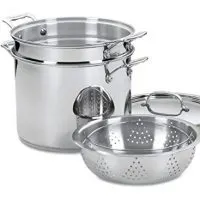
Sarah
Sunday 4th of September 2022
I just made these and they're soo delicious! I added a bit less salt per some recommendations and salted as I added all ingredients which was nice to control. I found dumpling wrappers at the asian grocery store which were vegan, there seemed to be a big variety at 99 Ranch where I live.
I tripled the recipe to freeze. I will definitely be making these again!
Also for the sauce I only used half the amount of water because I wanted a thicker consistency.
Asha
Saturday 10th of April 2021
Thank you for this delicious recipe. Your directions were perfect for both chutney and momo wrappers. (I used a prawn and bokchoy filling for the momos since that was what I had.) Our family loved it, thanks again Eva :)
Nyva
Saturday 13th of February 2021
Tried this but my chutney turned brown and bitter
Tori
Monday 8th of February 2021
Hi! Made these and love them. I've got some extra ingredients and wanted to make a batch to freeze. Can they be frozen? If so should I freeze before steaming? Any recommendations?
Tori
Monday 8th of February 2021
@Eva Agha, perfect thank you!
Eva Agha
Monday 8th of February 2021
Hi Tori, I'm so glad you enjoyed the dumplings! You can freeze them, I recommend doing it before cooking them, then cook them right from frozen. They will take a bit longer to cook, so just keep an eye on the first batch to get the timing right! It's just like how you would cook store-bought frozen dumplings :)
Gaby
Monday 25th of January 2021
Wonder if these would work with Bob’s Red Mill gluten free cup for cup flour...
Eva Agha
Monday 25th of January 2021
I think it would be hard to shape the momos if you use gluten free flour. I know you can make gluten free dumpling wrappers and it usually involves rice flour, so this may be something to look into!